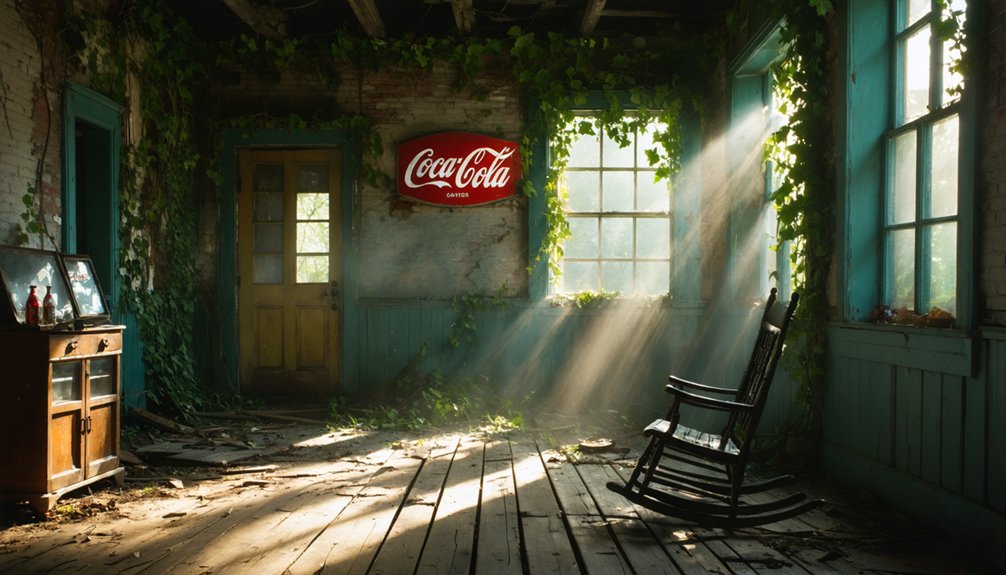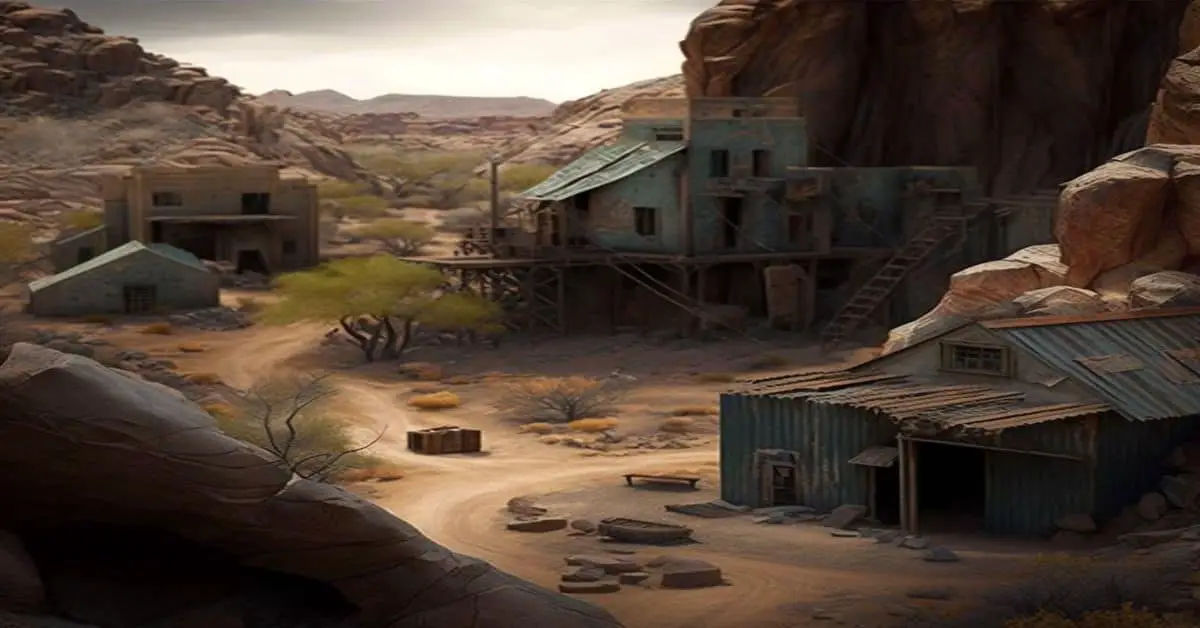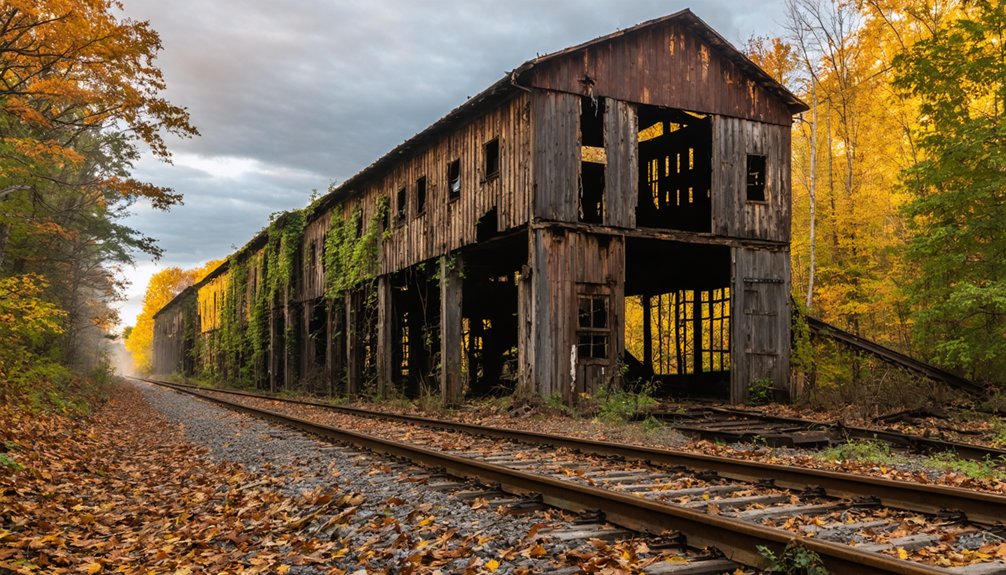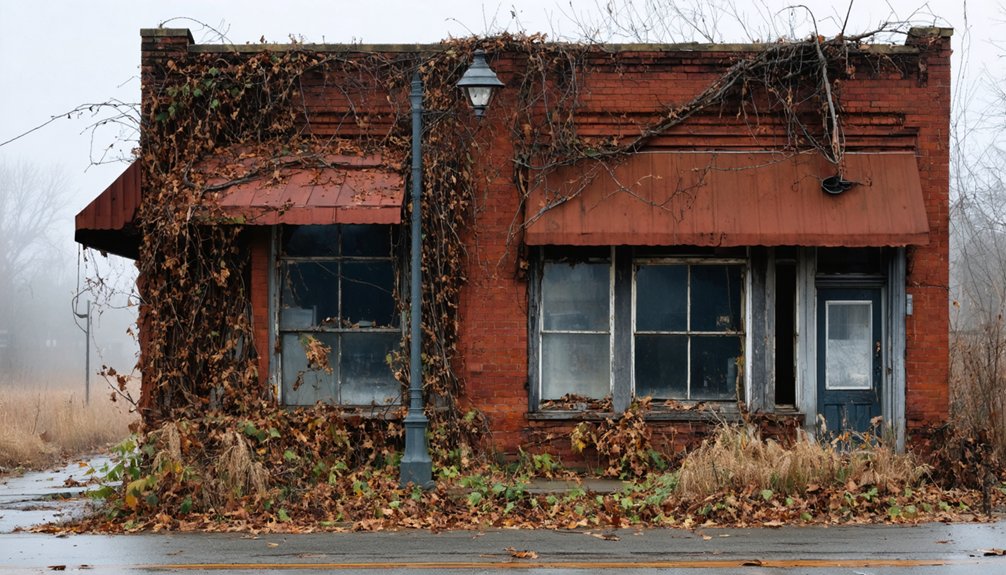You’ll find Stringtown’s story in Indiana’s rich coal mining history, where it thrived as a bustling community of 800 miners and 14 saloons in the late 1800s. The settlement grew from sawmills to coal operations, with German and Irish immigrants forming tight-knit communities around local churches and businesses. The devastating flood of 1913 marked its turning point, leading to widespread destruction and eventual abandonment by 1958. The complete disappearance of this once-vibrant mining town holds deeper tales of American industrial heritage.
Key Takeaways
- Stringtown was a thriving Indiana mining community that supported 800 miners and 14 saloons before becoming a ghost town.
- The 1913 flood caused widespread destruction and mass displacement, marking the beginning of Stringtown’s decline.
- All businesses in Stringtown had closed by 1958, following industrial shutdowns that devastated employment and drove residents away.
- The town completely vanished, leaving no physical traces, historical markers, or archaeological evidence of its existence.
- Originally centered on sawmills, Stringtown’s economy shifted to coal mining after being annexed by Indianapolis in 1897.
The Rise of Indiana’s Mining Settlement
As Indiana’s rich deposits of bituminous coal were first discovered along the Wabash River in 1736, the state’s mining industry wouldn’t truly flourish until the mid-1800s when underground mining operations began in earnest.
By 1905, coal mining rivaled farming as the primary economic activity in Indiana County.
You’ll find that early mining techniques relied heavily on manual labor and basic tools, but the introduction of steam-powered equipment in the early 1900s revolutionized coal extraction methods.
The promise of economic stability drew hundreds of workers to emerging settlements, transforming quiet rural areas into bustling mining communities. Three hundred miners worked in the Fontanet area during its peak operations.
Mining’s economic promise transformed Indiana’s landscape, as workers flocked to rural areas, building thriving communities from untamed wilderness.
Towns like Fontanet and Coal Bluff sprung up around these operations, complete with railways, roads, and essential services.
Supporting industries, such as the Laflin and Rand Power Company, established facilities nearby to manufacture the explosives needed for mining operations, creating a self-sustaining industrial ecosystem.
Early Industries and Economic Growth
You’ll find that Stringtown’s earliest commerce centered around its sawmills, which processed timber from the surrounding forests to support the region’s building needs.
As coal mining operations expanded rapidly between peak years, employing 600-800 miners, the economic landscape transformed from timber-based to mineral extraction.
The town, which was later annexed by Indianapolis in 1897, saw its local industries evolve with urban development.
Similar to how Fountaintown’s general store remained a fixture since the Civil War, the town’s general stores became crucial community hubs, where miners and their families could purchase essential goods, though these businesses remained heavily dependent on the coal industry’s success.
Sawmills Drive Local Commerce
While grist mills like Snoddy’s anchored early settlement in Stringtown, sawmills formed the backbone of local industrial growth during the early 19th century.
You’ll find that sawmill innovations transformed the abundant local timber into valuable construction materials, powering the region’s expansion. These operations weren’t just isolated businesses – they created interconnected supply chains that supported everything from housing construction to railroad development.
The timber economy flourished as sawmills met the growing demand for lumber in mining towns and infrastructure projects. You could see their influence in every wooden bridge, railroad tie, and miner’s home throughout the Lower Wabash region.
When the need for navigation dams and levees increased in the mid-20th century, local sawmills stepped up production, proving their lasting importance to the area’s development. For researchers and historians seeking information about Stringtown’s industrial heritage, clear disambiguation pages help trace the evolution of these vital sawmill operations.
Coal Mining Operations Expand
The discovery of bituminous coal along the Wabash River in 1736 set the stage for Stringtown’s transformation into a thriving mining community.
By the mid-1800s, you’d find underground mining operations taking hold, forever changing the landscape of this Indiana town.
When steam-powered mining technology revolutionized the industry in the early 1900s, surface mining expanded rapidly.
The construction of the C&EI coal road in 1872 proved essential, connecting Stringtown’s rich coal deposits to hungry markets.
Over 800 miners flocked to the area, spurring explosive growth in local businesses and housing.
However, labor relations grew tense as strikes erupted over wages, leading to racial conflicts between white miners and black strikebreakers.
Despite these challenges, the mining operations continued to drive Stringtown’s economy, supporting everything from saloons to grocery stores.
General Stores Shape Communities
As Stringtown’s coal mining operations expanded in the late 1800s, general stores emerged as fundamental community hubs that served far more than basic retail needs.
You’d find these establishments adapting to meet the demands of coal miners and their families, offering everything from groceries and dry goods to household necessities.
The retail evolution of these stores reflected the community’s growth, with entrepreneurs like Snoddy expanding into multiple locations by 1877.
Beyond commerce, these spaces fostered essential community connections, housing post offices and providing gathering spots where miners shared news and fellowship.
The industrial landscape near Garvin and Stringtown transformed dramatically as manufacturing facilities moved into the area.
Similar to the dealers in almost everything approach of historic establishments, these versatile merchants adapted their inventory to serve diverse community needs.
You’ll appreciate how store owners diversified their businesses, adding grist mills and flour production to serve the expanding population.
When railroads arrived in 1872, these stores became even more critical to regional trade and cultural exchange.
Daily Life in Historic Stringtown
During Stringtown’s heyday, you’d find miners and railroad workers gathering at the town’s fourteen bustling saloons after their shifts, while families shopped at the various grocery and dry goods stores along the main thoroughfare.
You’d see the 16-room hotel hosting travelers and business people, while the millinery shop, barber, and butcher served the daily needs of approximately 800 miners and their families. Like many towns of its era, Stringtown was established near a clean water source that sustained its growing population.
The Catholic church and Church of God formed essential community hubs where residents of German and Irish descent would come together for worship and social events, strengthening the town’s cultural fabric. Much like in Elkinsville, the community emphasized love and fellowship among its residents.
Community Gathering Spots
Life in historic Stringtown revolved around vibrant community gathering spots that shaped the town’s social fabric. You’d find the town’s 14 saloons bustling with miners sharing stories over drinks, while the local barber shop buzzed with daily gossip and news.
These community hubs created a rich tapestry of social dynamics among residents. The 16-room hotel and Catholic church served as anchors for both travelers and locals, hosting gatherings that strengthened community bonds. The German and Irish immigrants formed tight-knit communities around these gathering places in the early days of settlement.
You could catch up on news at the post office or browse the grocery and dry goods stores, where neighbors would often meet. The streets and sidewalks connected these crucial spaces, fostering spontaneous interactions among Stringtown’s diverse population.
Even during challenging times, these gathering spots remained fundamental to maintaining the town’s spirit.
Local Industries Shape Life
Coal mining dominated Stringtown’s economic and social landscape, employing roughly 600 men in the bustling mines that defined the town’s identity.
You’d find the community’s pulse beating to the rhythm of mine operations, with labor relations shaping daily interactions among workers from diverse backgrounds.
Your economic dependencies would’ve been clear as a resident – the mines dictated everything. Local businesses, from grocery stores to saloons, thrived on miners’ wages. The coal companies built your housing, keeping you tethered to their operations.
When you walked Stringtown’s streets, you’d encounter a vibrant mix of cultures and ethnicities, all drawn by mining opportunities.
Yet this industrial foundation proved unstable – when labor disputes erupted and coal production declined, the town’s fate was sealed, leading to its eventual abandonment.
Natural Disasters and Environmental Impact
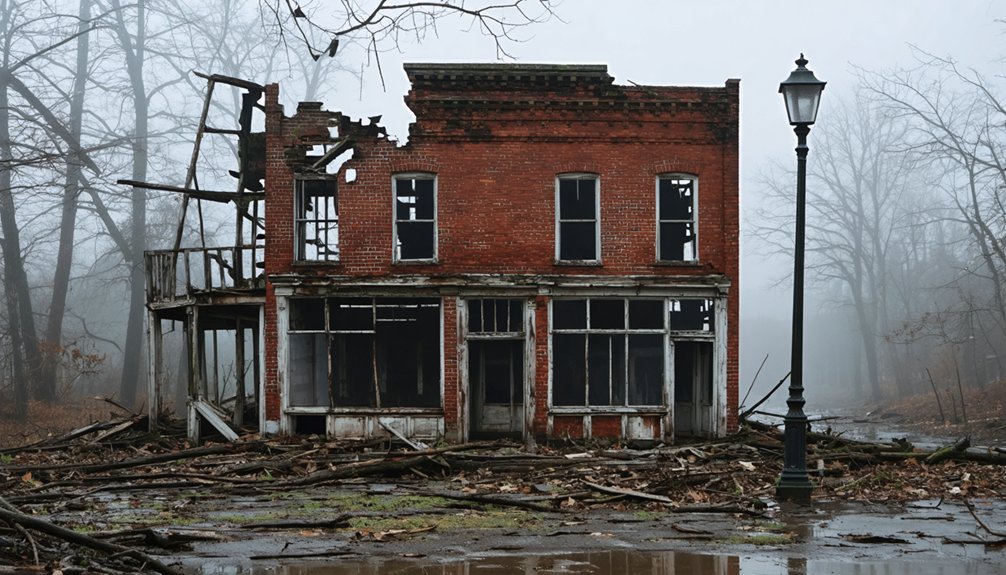
While Stringtown initially flourished as a bustling mining community, environmental disasters and industrial activities ultimately shaped its decline into a ghost town. The devastating flood of 1913 marked a turning point when the town’s levee failed, leading to widespread destruction and permanent changes in the community’s makeup.
Once-thriving Stringtown crumbled under nature’s fury and industry’s toll, as the great flood of 1913 sealed its fate.
- Coal mining operations that once employed 800 workers left lasting scars on the landscape and contributed to environmental degradation.
- The 1913 flood triggered mass displacement, forever altering the neighborhood’s ethnic composition and social fabric.
- Insufficient infrastructure and recurring environmental challenges made recovery increasingly difficult.
You’ll find that these natural disasters, combined with the environmental toll of mining activities, created a perfect storm that accelerated Stringtown’s transformation from a thriving industrial hub to an abandoned settlement.
The Decline of Local Commerce
Beyond the environmental challenges that plagued Stringtown, the town’s commercial decline tells a story of economic upheaval and social transformation. You would’ve found a bustling community of 800 miners supporting 14 saloons, multiple stores, and professional services during its peak.
But labor tensions sparked devastating social unrest when coal companies hired black strikebreakers, leading to violent confrontations that fractured the community.
The ripple effects triggered widespread business closures, with the last establishments shuttering by 1958. By the 1960s, industrial shutdowns had devastated employment, while deteriorating housing drove residents away.
The town’s commercial fabric unraveled further as crime increased and youth opportunities vanished. Though modern redevelopment plans have emerged, they’re a stark contrast to Stringtown’s once-thriving business district that supported thousands.
Notable Historical Landmarks
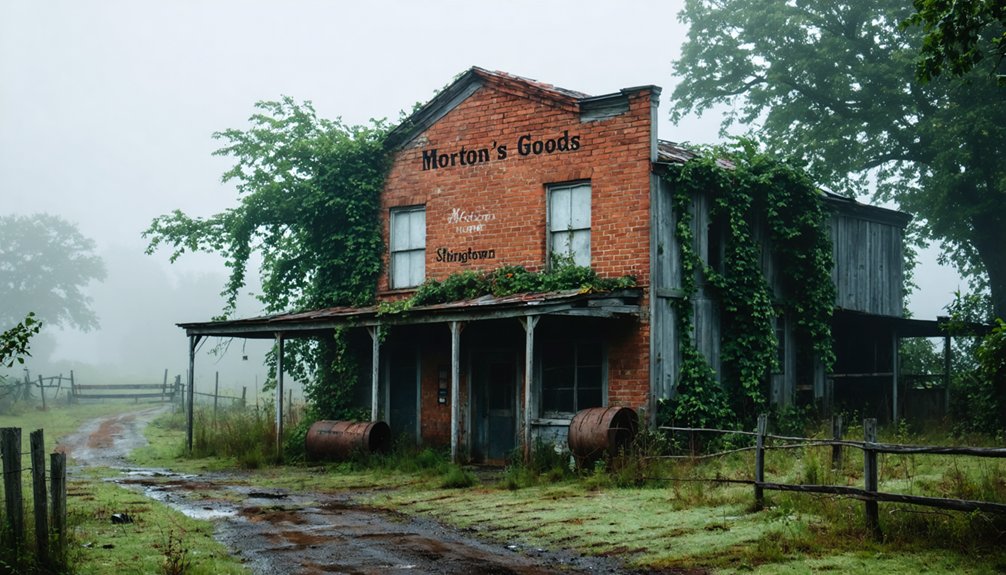
Standing as silent witnesses to Stringtown’s industrial heritage, the town’s historical landmarks chronicle its evolution from an agricultural settlement to a bustling railroad community in the 1870s.
You’ll discover an array of haunted landmarks and architectural heritage sites that tell the story of immigrant railroad workers and their modest Carpenter-Builder style homes built on narrow lots.
- The historic 1857 train tunnel, stretching 1,731 feet, where watchman Henry Dixon’s lantern-carrying ghost still reportedly roams
- Original single-family cottages showcasing German and Irish immigrant craftsmanship
- Post-1913 flood structures that mark the community’s resilience and cultural transformation
These landmarks paint a vivid picture of Stringtown’s industrial past, from its railroad shops to the devastating flood that reshaped both its physical and social landscape.
Population Shifts and Cultural Changes
The cultural tapestry of Stringtown evolved dramatically from its humble beginnings as a simple string of houses along a dusty road. When 800 miners arrived, they transformed this quiet settlement into Miami County’s largest town, reaching 2,500 residents by the 1870s.
You’d have witnessed significant demographic changes as merchants, professionals, and diverse tradespeople established themselves, creating a vibrant community with multiple businesses and cultural institutions.
The town’s social fabric underwent profound shifts during labor disputes, as cultural influences collided when coal companies introduced non-union black workers to replace striking white miners. This decision sparked violent conflicts that ultimately contributed to the community’s decline.
The population dwindled as businesses closed, schools shuttered, and the once-thriving mining town gradually emptied, marking the end of Stringtown’s dynamic cultural era.
Preservation and Heritage Sites
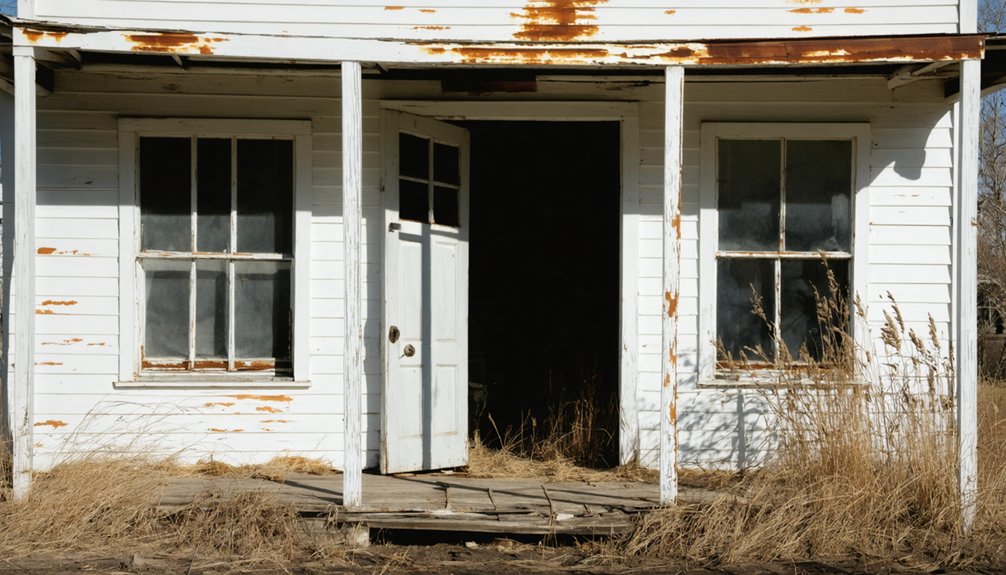
Unlike many of Indiana’s documented ghost towns that maintain visible ruins or restored structures, Stringtown has completely vanished from Miami County’s landscape without leaving a single trace of its once-bustling community.
The preservation challenges are particularly stark, as you won’t find any historical markers, archaeological surveys, or heritage sites commemorating this lost settlement.
Today’s heritage awareness efforts reveal:
- No active preservation groups or volunteer initiatives maintain the site
- No archaeological excavations or formal documentation exist in public archives
- No historical plaques or interpretive signs mark Stringtown’s former location
Unlike preserved ghost towns such as New Harmony or Hindostan, Stringtown’s complete absence of physical remains makes it unlikely to receive formal heritage designation without new discoveries through archaeological research or archival documentation.
Frequently Asked Questions
What Indigenous Tribes Originally Inhabited the Stringtown Area Before Settlement?
Ever wonder about the tribal history of this land? The Miami tribe originally controlled the hunting grounds, sharing cultural significance with the Lenape, who were later invited to settle alongside Wea, Shawnee, and Potawatomi peoples.
Are There Any Documented Paranormal Activities Reported in Abandoned Stringtown Buildings?
You’ll find limited verified ghost sightings in Stringtown’s haunted locations. While nearby Indiana ghost towns report paranormal activity, specific documented accounts from Stringtown’s abandoned buildings aren’t well detailed in public records.
How Did the Great Depression Specifically Impact Stringtown’s Economy?
Like a Netflix stock crash, the Great Depression devastated your town’s manufacturing base. You’d see widespread unemployment, factory closures, agricultural decline, and housing foreclosures that permanently crippled Stringtown’s economic significance.
What Transportation Routes Connected Stringtown to Neighboring Communities?
You’ll find Main Street and Stringtown Road formed the primary road connection, while railroad lines from the 1870s linked the area to Evansville and Indianapolis for both freight and passenger travel.
Did Any Notable Outlaws or Criminals Have Connections to Stringtown?
While no major outlaws are documented, you’ll find Frank Kelly made headlines for violent confrontations during mining strikes, including a fatal shootout with a strike breaker in Stringtown.
References
- https://indyencyclopedia.org/stringtown/
- https://www.wikiwand.com/en/articles/Stringtown
- http://freepages.rootsweb.com/~gtusa/history/usa/in.htm
- https://en.wikipedia.org/wiki/Stringtown
- https://michaelkleen.com/2021/09/28/coles-county-ghost-towns-bachelorsville-dog-town-and-string-town/
- https://theclio.com/tour/2678
- https://www.journalreview.com/stories/rise-and-fall-of-stringtown-an-interesting-tale
- https://www.in.gov/dnr/reclamation/files/re-IE_Citizens_Guide-IntroductionAndHistory.pdf
- https://www.visitindiana.com/blog/post/fontanet-tiny-town-blew-up/
- https://www.indianacountyceo.com/live-and-visit/history-heritage/
